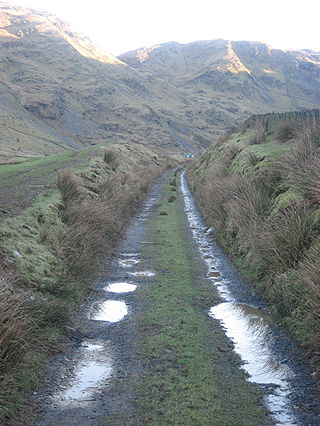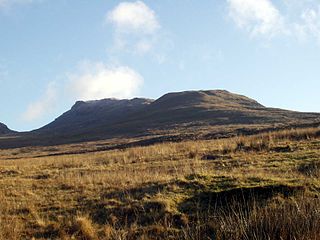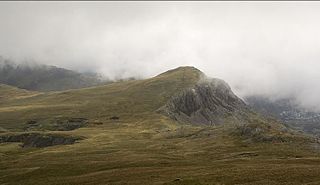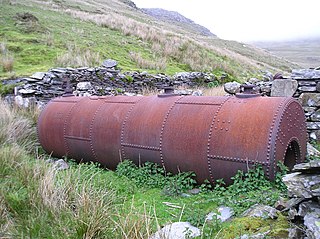
Snowdonia, or Eryri, is a mountainous region and national park in North Wales. It contains all 15 mountains in Wales over 3000 feet high, including the country's highest, Snowdon, which is 1,085 metres (3,560 ft) tall. These peaks are all part of the Snowdon, Glyderau, and Carneddau ranges in the north of the region. The shorter Moelwynion and Moel Hebog ranges lie immediately to the south.

Blaenau Ffestiniog is a town in Gwynedd, Wales. Once a slate mining centre in historic Merionethshire, it now relies much on tourists, drawn for instance to the Ffestiniog Railway and Llechwedd Slate Caverns. It reached a population of 12,000 at the peak development of the slate industry, but fell with the decline in demand for slate. The population of the community, including the nearby village Llan Ffestiniog, was 4,875 at the 2011 census: the fourth most populous in Gwynedd after Bangor, Caernarfon and Llandeiniolen. The population not including Llan is now only about 4,000.

Tanygrisiau is a village and area within Blaenau Ffestiniog in the upper end of the Vale of Ffestiniog in the county of Gwynedd, north-west Wales. It can be found along the southern side of the Moelwyn mountain range and dates to around 1750. It joins onto the semi-urban area of Blaenau Ffestiniog, and is in the community of Ffestiniog; located between 650 feet (200 m) and 750 feet (230 m) above sea level. it is in the electoral ward of Bowydd and Rhiw which had a 2011 census population of 1878. The village itself has a population of around 350.

The Croesor Tramway was a Welsh, 2 ft narrow gauge railway line built to carry slate from the Croesor slate mines to Porthmadog. It was built in 1864 without an Act of Parliament and was operated using horse power.

Moelwyn Bach is a mountain in Snowdonia, northern Wales and forms part of the Moelwynion. It is connected to its parent peak Moelwyn Mawr via the Craigysgafn ridge.

Allt-fawr is a mountain in Snowdonia, North Wales and forms part of the Moelwynion group.

Moel-yr-hydd is a subsidiary summit of Moelwyn Mawr in Snowdonia, North Wales and forms part of the Moelwynion.

Manod Mawr is a mountain in North Wales and forms part of the Moelwynion. Although known as a mountain in the eastern Moelwyns, it and its sister peaks are sometimes known as the Ffestiniog hills.

The Moelwynion are a group of mountains in central Snowdonia, north Wales. They extend from the north-east of Porthmadog to Moel Siabod, the highest of the group. The name derives from the names of two of the largest mountains in the group, Moelwyn Mawr and Moelwyn Bach, 770m and 710m, respectively. Moel Siabod, to the north, is the highest at 872m.

Croesor is a small village in Gwynedd, Wales, located at the foot of Cnicht, in Cwm Croesor, in the community of Llanfrothen. The Croesor Tramway travelled along the bed of the cwm, before rising steeply to Bwlch Rhosydd via Croesor Incline.

The Ffestiniog Power Station is a 360-megawatt (MW) pumped-storage hydroelectricity scheme near Ffestiniog, in Gwynedd, north-west Wales. The power station at the lower reservoir has four water turbines, which can generate at full capacity within 60 seconds of the need arising. The scheme has a storage capacity of around 1.44 GWh (5.2 TJ) at maximum output for four hours, and the capacity to power the whole of North Wales for several hours.

Rhosydd quarry was a slate quarry in the Moelwyn mountains, northeast of Porthmadog in North Wales.

Moelwyn Mawr North Ridge Top is a top of Moelwyn Mawr in Snowdonia, North Wales and forms part of the Moelwynion. From its summit, which directly overlooks Bwlch Rhosydd, can be seen Cnicht, Allt-fawr and Moel-yr-hydd. A recently discovered 'top' has only received attention from Nuttall baggers.

Y Gamallt is a mountain located in the Migneint in Snowdonia, North Wales. It forms part of the Arenig mountain range being separated from the Moelwynion range at the head of Cwm Teigl.

Wrysgan quarry was a slate quarry near the village of Tanygrisiau, Blaenau Festiniog, North Wales. It was worked intermittently from the 1830s, and was worked continuously from c.1850 until 1946. Wrysgan was an underground slate quarry, which was located on a small inaccessible site, some 1,390 feet (420 m) above sea level, to the west of Cwmorthin.

Moelwyn quarry is a defunct slate quarry located to the south of the village of Tanygrisiau, north Wales. Some initial prospecting was carried out in the 1820s and again in the 1840s, but it was 1860 before a company was formed, and chambers were excavated. The quarry was never a financial success, and operated sporadically until its demise in 1897. Despite the poor results, a spectacular series of seven inclines were constructed, to enable slates to reach the Ffestiniog Railway. The quarry was hampered by lack of a good water supply, and the mill was constructed between inclines 4 and 5, where water could be obtained from Llyn Stwlan. As in many quarries, barracks were provided, but these were occupied by whole families, living on the mountain, rather than used as lodgings for the quarrymen during the working week. Even in its remote location, there was still a concern for education, with basic literacy classes being run in the 1860s.

Fron-Boeth and Pant Mawr quarries were two closely related and interconnected quarries on the western slopes of Moelwyn Mawr in Gwynedd, North Wales. Pant Mawr operated from around 1850 to 1879, and was partly re-opened in 1886 when it was amalgamated with Fron-Boeth. Both quarries closed during the First World War. Finished product was transported to the slate quays of Porthmadog by the Croesor Tramway.

Snowdonia Slate Trail is a long distance footpath, running 83 miles (134 km) as a circular route around Northern Snowdonia starting from Bangor. It passes through the main areas and heritage sites associated with the slate industry, and also through some of the major landscapes.


















